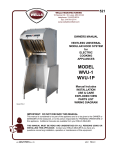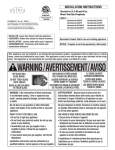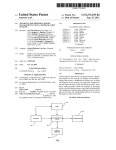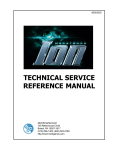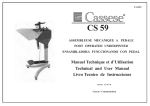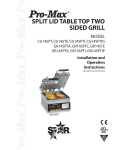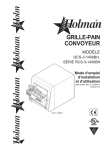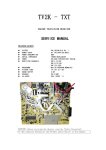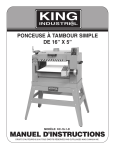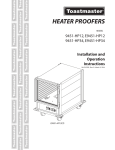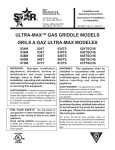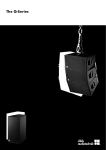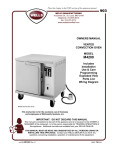Download Ultra Max UM1850A-240V Specifications
Transcript
® ELECTRIC CONVEYOR OVEN ® MODEL UM1833A-208V UM1833A-240V UM1850A-208V UM1850A-240V Installation and Operation Instructions ® 2M-Z9844 Rev. D 10/28/2010 ® UM1850A SAFETY SYMBOL These symbols are intended to alert the user to the presence of important operating and maintenance instructions in the manual accompanying the appliance. RETAIN THIS MANUAL FOR FUTURE REFERENCE NOTICE Using any part other than genuine Star factory supplied parts relieves the manufacturer of all liability. Star reserves the right to change specifications and product design without notice. Such revisions do not entitle the buyer to corresponding changes, improvements, additions or replacements for previously purchased equipment. Due to periodic changes in designs, methods, procedures, policies and regulations, the specifications contained in this sheet are subject to change without notice. While Star International Holdings Inc., Company exercises good faith efforts to provide information that is accurate, we are not responsible for errors or omissions in information provided or conclusions reached as a result of using the specifications. By using the information provided, the user assumes all risks in connection with such use. MAINTENANCE AND REPAIRS Contact your local authorized service agent for service or required maintenance. Please record the model number, serial number, voltage and purchase date in the area below and have it ready when you call to ensure a faster service. Model No. Serial No. Voltage Purchase Date Authorized Service Agent Listing Reference the listing provided with the unit or for an updated listing go to: Website: E-mail Telephone: www.star-mfg.com [email protected] (800) 807-9054 Local (314) 781-2777 Service Help Desk 8:00 am to 4:30 p.m. Central Standard Time Business Hours: Telephone: (800) 264-7827 Local (314) 781-2777 Fax: (800) 396-2677 Local (314) 781-2714 E-mail [email protected] [email protected] [email protected] Website: www.star-mfg.com Mailing Address: Star International Holdings Inc., Company 10 Sunnen Drive St. Louis, MO 63143 U.S.A 2 SPECIFICATIONS UM1833A-208V, UM1833A-240V Rating/Connection: Electrical Supply: 6,400 Watts (6,000 element), 32/29 Amps at 208/240V NEMA 6-50 plus with six foot oil-resistant cord Separate 50 Amp 208/240VAC, single phase, 50/60 Hz service per Oven Approximate Weight: (1833 Oven with Legs): Installed - 180 Lbs (81.8 kg), Shipping - 210 Lbs (95.5 kg) Dimensions: Width: 51.2" (130.0 cm) - Oven with Shelves Depth: 30.4" (77.2 cm) Height: 20.0" (50.8 cm) - Single Oven with Legs 36.0" (91.4 cm) - Double Oven with Legs Recommended Minimum Clearances: Rear of Oven to Wall 0" (0 cm) Conveyor Extensions to Wall 6" (15.2 cm) UM1850A-208V, UM1850A-240V Rating/Connection: 6,400 Watts (6,000 element), 32/29 Amps at 208/240V NEMA 6-50 plus with six foot oil-resistant cord Electrical Supply: Separate 50 Amp 208/240VAC, single phase, 50/60 Hz service per Oven Approximate Weight (1850 Oven with Legs): Installed - 210 Lbs (95.5 kg), Shipping - 240 Lbs (109.1 kg) Dimensions: Width: 50.0" (127.0 cm) Depth: 30.4" (77.2 cm) Height: 20.0" (50.8 cm) - Single Oven with Legs 36.0" (91.4 cm) - Double Oven with Legs Recommended Minimum Clearances: Rear of Oven to Wall 0" (0 cm) Conveyor Extensions to Wall 6" (15.2 cm) UM1833 WITH INFEED/EXIT SHELVES A A2 24.1 [612] TOP VIEW 1833 W\OUT SHELVES SHOWN 0 C A = 51.2 (1300) A1= 50.0 (1270) A2= 33.0 (838) B = 30.4 (772) C = 16.0 (406) C1= 20.0 (508) STACKED DIMENSION = C + C1 UM1850 A1 11.4 [291] 2.0 [51] 14.5 [369] CONTROL BOX DOOR OPEN 8.2 [208] B 0 0 C1 10.6 [269] 21.0 [533] 22.0 [559] FRONT VIEWS END VIEW 2 14.5 [369] GENERAL INFORMATION This equipment is designed and sold for commercial use only by personnel trained and experienced in its operation and is not sold for consumer use in and around the home nor for use directly by the general public in food service locations. First and foremost, each crate should be examined before signing the Bill of Lading to report any visible damage by the trucker in transit and to account for the proper number of crates. If there is apparent damage, arrangements should be made to file a claim against the carrier. Interstate Commerce Regulations require that the claim must be initiated by the consignee. Proper and secure storage facilities should be arranged for the oven(s) if necessary to protect it from outdoor or damp conditions at all times before installation. -IMPORTANTWhen you have all the crates unloaded, open the crates and remove all plastic covers. Inspect at once for concealed damage. If anything appears to be damaged, contact the appropriate persons immediately to file a damage claim. After completing this inspection, finish unpacking the oven. Be sure to remove all paper protection and packing material from the unit prior to heating. CAUTION FOR YOUR SAFETY DO NOT STORE OR USE GASOLINE OR OTHER FLAMMABLE VAPORS AND LIQUIDS IN THE VICINITY OF THIS OR ANY OTHER APPLIANCE. INSTALLATION The ovens are equipped for the voltage indicated on the nameplate mounted on the rear of the control box. They will operate on alternating current (AC) only. A cord is provided with a NEMA 6-50 plug. A matching receptacle with 50A supply must be provided. WARNING DO NOT CONNECT TO DIRECT CURRENT (DC). The installation of the electric oven should conform to the: NATIONAL ELECTRIC CODE AND ALL LOCAL ELECTRIC CODES AND ORDINANCES AND THE LOCAL ELECTRIC COMPANY RULES AND REGULATIONS. PURCHASER'S RESPONSIBILITY It is the responsibility of the purchaser: 1. To see that the electric services for the oven are installed on site in accordance with the manufacturer's specifications. 2. To unload, uncrate, and install the oven in its proper location and in accordance with this installation operation manual. 3. To see that electric services are connected properly by a qualified installer of your choice. All such connections must be in accordance with applicable code requirements. 4. To arrange for inspection and operation check-out by an authorized service technician. The warranty becomes effective upon verification of proper installation. 4 IMPORTANT SAFETY INFORMATION Do not attempt to operate the oven until connection of utility service has been fully inspected by an authorized service technician or a Star Service Representative. This service is required by Star in order to assist the purchaser in proper start-up of the oven on site. Please note the specific details on the Warranty and make certain that service connections are made to proper utility services. The warranty shall not apply if the oven is started up and operated prior to the utilities and oven being inspected and check-out made by an authorized service technician or a Star Service Representative. CAUTION IMPROPER INSTALLATION, ADJUSTMENT, ALTERATION, SERVICE, OR MAINTENANCE CAN CAUSE PROPERTY DAMAGE, INJURY, OR DEATH. READ ALL INSTRUCTIONS THOROUGHLY BEFORE INSTALLING OR SERVICING THIS EQUIPMENT. CAUTION Minimum clearances must be maintained from all walls and combustible materials. Minimum clearances for this unit should be 0 inches from the rear (rear bumpers provided must be in place) and 6 inches from both sides. Keep the oven free and clear of all combustible material. CAUTION Do not obstruct the ventilation holes in the control panels as these provide cooling air for the controls. WARNING The oven is to be operated only on the type of electricity shown on the specification plate. INSTALLATION INFORMATION THE INSTALLATION INSTRUCTIONS CONTAINED HEREIN ARE FOR THE USE OF QUALIFIED INSTALLATION AND SERVICE PERSONNEL ONLY. INSTALLATION OR SERVICE BY OTHER THAN QUALIFIED PERSONNEL MAY RESULT IN DAMAGE TO THE OVEN AND/OR INJURY TO THE OPERATOR. Qualified installation personnel are individuals, a firm, a corporation, or a company which either in person or through a representative are engaged in and responsible for: 1. The installation of electrical wiring from the electric meter, main control box, or service outlet to the electric appliance. Qualified installation personnel must be experienced in such work, familiar with all precautions required, and have complied with all requirements of state or local authorities having jurisdiction. LOCATION The well-planned and proper placement of your oven will result in long-term operator convenience and satisfactory performance. It is essential that an adequate air supply to the oven be maintained to provide a sufficient flow of ventilation air. Follow these guidelines: 1. Place the oven in an area that is free of drafts. 2. Keep the oven area free and clear of all combustibles such as paper, cardboard, flammable liquids, and solvents. 3. Do not place the oven on a curb base or seal to a wall. This will restrict the flow of air and prevent proper ventilation to the blower motors. This condition must be corrected to prevent permanent damage to the oven. 4. On all models, tripping of the blower motor's thermal overload device indicates an excessive ambient temperature at the back of the oven. This condition must be corrected to avoid permanent damage to the oven. 5 This appliance must be installed on a sturdy counter or stand using the feet provided for cleaning clearance. As a minimum, 24" of clearance on the discharge end of the oven should be allowed for removal of the conveyor assembly if the oven is not on a mobile cart. Also allow room for a service technician to access the control box door and the fan motor cover over the rear of the oven if the oven is not movable. CAUTION Any surface the oven is mounted on should have a raised area around the perimeter to prevent the oven from accidentally sliding off the edge. Serious injury or death could occur if the oven falls on a person. CAUTION Any cart that the oven is mounted on must be deep and wide enough to provide a stable platform. A cart with a narrow stance could allow the oven to tip over, causing property damage or serious harm to people. VENTILATION Local codes prevail. These are the "authority having jurisdiction" as stated by the National Fire Protection Association, Inc. in NFPA 96-Latest Edition. For further ventilation information see below. A ventilation hood may be required to remove heat and cooking odors. The hood and HVAC installation must meet local codes to gain approval by the authority having jurisdiction. Requirements may vary throughout the country depending on the location by city, county, and state. Obtain information from the authority having jurisdiction to determine the requirements for your installation. Obtain information and review copies of codes or documents that will be used to inspect and approve your installation. Your ventilation hood supplier and HVAC contractor should be contacted to provide guidance. CAUTION Prevent airflow through the cooking tunnel. Air must NOT be directed onto the oven's front or rear or to the sides of the cooking area. This can cause incomplete or uneven baking and increased energy consumption. ELECTRICAL CONNECTION Before making any electrical connections to this unit, check that the power supply is adequate for the voltage, amperage, and phase requirements stated on the rating plate. A wiring diagram is included herewith. When installed, this appliance must be electrically grounded and its installation must comply with the National Electric Code, ANSI-NFPA 70, latest version, manufacturer's installation instructions, and applicable local municipal building codes. In Canada, all electrical connections are to be in accordance with CSA C22.1 - Canadian Electrical Code Part 1 and/or local codes. WARNING This appliance is equpped with a three-prong (grounding) plug for your protection against shock hazard and should be plugged directly into a properly grounded three-prong receptacle. Do not cut or remove the grounding prong from this plug. 6 STACKING INSTRUCTIONS The following instructions should be followed when stacking more than one unit. Single Oven (or Bottom) Cart Install: 1. Remove door, conveyor, and finger assemblies. 2. Unbolt unit from shipping crate (2 bolts). 3. Turn unit on front as shown. 4. Thread the four legs into the bottom of the oven. 5. CAREFULLY lift oven upright. Stacked Oven Install Preparation: 1. Remove door, conveyor, and finger assemblies. 2. Unbolt unit from shipping crate (2 bolts). 3. Turn unit on front as shown. 4. Remove top of lower oven (4 screws total, 2 each front and rear) and bolt to stacked oven base using 3/8 - 16 bolts. 5. Place top oven on lower unit and re-attach with screws for top of lower oven. OPERATING INSTRUCTIONS DO NOT ATTEMPT TO OPERATE THE OVEN until connection of utility service and installation has been fully inspected (start-up checkout) by an authorized service technician or a Star Service Technician in order to assure the oven is properly installed and in working order. The warranty becomes effective upon verification of proper installation. CAUTION DO NOT WORK AROUND THE CONVEYOR BELT WITH LONG HAIR, LOOSE CLOTHING, OR DANGLING JEWELRY. GETTING CAUGHT IN THE BELT COULD RESULT IN DISMEMBERMENT OR FATAL INJURY. Unless specified otherwise, conveyor travel is factory set for left to right operation when facing the front of the oven. If a direction change is required, refer to "DISPLAY INFORMATION," section 3 for instructions on how to program the controller for a direction change. In addition, the conveyor belt must be changed to travel in the new direction. SAFETY OPERATING INSTRUCTIONS The information contained in this section is provided for the use of qualified operating personnel. Qualified operating personnel are those who have carefully read the information contained in this manual, are familiar with the functions of the oven and/or have had previous experience with the operation of the equipment described. Adherence to the procedures recommended herein will assure the achievement of optimum performance and long, trouble-free service. 7 Please take time to read the following safety operating instructions. They are the key to the successful operation of your Ultra-Max Conveyor Oven. General Safety Tips: SAFETY TIPS For your safety, read before operating. If you smell gas: 1. If the oven needs to be moved for any reason, the power must be disconnected from the unit before doing so. 2. DO NOT remove the control box cover unless the oven is unplugged. 1. DO NOT try to light any appliance. 2. DO NOT touch any electrical switches. 3. Use an exterior phone to call your gas supplier immediately. 4. If you cannot reach your gas supplier, call the fire department. In the event of a power failure: 1. Turn all switches off. 2. DO NOT attempt to operate the oven until the power is restored. "HEAT" LIGHT OPERATION To turn the oven on: 1. Push the power switch to "ON." 2. After the fan begins to build pressure, the pressure switch will provide power to the control board to engage the heating element contactor. You should hear an initial "click" from the contactor as it begins to heat. To adjust the time and temperature: 1. Press the DOWN and UP arrows ( ) at the same time. Hold for four seconds until the TIME display goes blank. 2. Press the ENTER button ( ) to switch between TIME and TEMPERATURE. 3. Press the UP arrow ( ) to increase or the DOWN arrow ( ) to decrease the TIME or TEMPERATURE. Hold either button down for faster display changes. ON 4. After five seconds, the new numbers will be saved and the oven will display the new settings. OFF To Start: To turn the oven off: Push power switch "ON". 1. Push the power switch to "OFF." The oven is equipped with a cool-down feature for motor shaft and bearing protection. This enables the blower motor(s) to run regardless of the controller status. The blower(s) continue to run until the oven cools to a safe temperature. If burner does not lght in one minute push the power switch to the"OFF" position and wait five minutes. After five minutes, retry. Adjusting TIME and TEMPERATURE: 1) Press the up and down buttons ( ) at the same time, hold for four seconds until TIME display goes blank. 2) Press the enter button ( and TEMPERATURE. ) to switch between TIME 3) Press the up button ( ) to increase or the down button ( ) to decrease TIME or TEMPERATURE. Hold button down for faster display changes. 4) After five seconds, the new numbers will be saved and the oven will display new settings. ® 8 DISPLAY INFORMATION When operating the oven, there are three levels of access: 1. Store Level - General employees would know these functions and how to change them. While the oven is running, enter this mode by holding the DOWN and UP arrows ( ) simultaneously for four seconds. The TIME display goes blank and the TEMP setpoint is displayed. Adjust with the DOWN or UP arrows. The ENTER button ( ) toggles between TIME and TEMP. The parameter that can be adjusted is displayed, the other is blank. When TIME and TEMP are adjusted as needed, wait five seconds and SAVE is displayed. The values are accepted and the controller begins controlling to these new values. The conveyor continues to operate at the same speed until a new value is accepted. The temperature control output should be OFF during changes. 2. Manager Level - This is a lock so that TIME and TEMP cannot be changed even at the Store Level. While the oven is running, enter this mode by holding the DOWN and UP arrows simultaneously for 4 seconds. The TIME display goes blank and the TEMP setpoint is displayed. Release the UP arrow and continue to hold the DOWN arrow for an additional 4 seconds. The TEMP display shows LOC as the TIME display shows nO, which indicates that the TIME/TEMP parameters can be changed after reaching the STORE level. yES indicates that the parameters cannot be changed even after entering the STORE level. The LOC setting can be toggled using the ENTER button ( ). ADDITIONAL FUNCTIONS The conveyor belt direction and the temperature display can be changed on the conveyor oven by a qualified technician. To change the belt direction, the technician must reverse the motor direction and rotate the conveyor belt for proper oven function. A technician can also change the temperature display from Fahrenheit to Celsius. These changes can be made by the technician during the startup/check-out or at a later date. ERROR CODES Error codes will display as flashing text messages for diagnostic purposes. Any temperature or thermocouple error should turn the temperature output OFF and leave the conveyor running at the same speed. The belt error should turn the temperature output OFF. The speed error should display when the motor is unable to settle at the chosen speed. This might occur if a fast speed is chosen that the motor is unable to spin fast enough to achieve. The speed signal output will remain the same but the display will flash the error message. 9 BAKE TIME VERSUS TEMPERATURE 1. Bake time is actually conveyor speed and is defined as the time the product is actually in the oven. This is measured by noting the time when the leading edge of the product enters the oven and the time the leading edge of the product leaves the oven. This is adjusted by using the conveyor speed controller. 2. Bake temperature is adjusted by changing the setpoint of the temperature controller to the desired bake temperature. When the oven reaches the desired temperature, the red dot in the lower right corner of the temperature display will turn off and on as the controller maintains the temperature. 3. When establishing a bake time and temperature for a given product, the general rule shall be as the bake time increases the bake temperature decreases and the reverse is also true; increase temperature, decrease time. However, there are limits to the above rule. Going to extremes will result in a burnt exterior and raw interior or it will result in a very light color but over-baked product. 4. Once a good bake has been established, the fine adjustments should be made by holding either the bake time or bake temperature constant, then varying the other. CONVEYOR SPEED Bake Time (Conveyor Speed) - As stated previously, bake time (conveyor speed) is defined as the amount of time elapsed between the time the leading edge of the product enters the oven and the leading edge of the product exits the oven. Bake time is controlled by adjusting the digital speed controller. The setting on the control panel indicates the actual bake time. Bake time will be the same for any size product. TIME OF DELIVERY The time of delivery is the amount of elapsed time between the period when the leading edge of the product enters the oven and the trailing edge of the product is fully discharged and is ready to be delivered to the customer. Time of delivery changes if the product size changes. 40 (DELIVERY) 32 (DELIVERY) 24 (BAKE) 6:00 (BAKE) 8:00 (DELIVERY) 10:00 (DELIVERY) BAKE vs. DELIVERY TIME Time to Delivery changes with product but Bake Time remains constant at a steady conveyor speed. 10 Tip: Train yourself not to pull the product out of the oven when the leading edge comes out. Always wait until the entire product has passed under the air nozzle holes - the product needs this time to fully bake. CLEANING INSTRUCTIONS Follow this recommended cleaning schedule for proper oven performance: CAUTION DISCONNECT THE POWER SUPPLY BEFORE SERVICING OR CLEANING THIS OVEN. SAFEGUARD THE POWER SO IT CANNOT BE ACCIDENTALLY RESTORED. FAILURE TO DO SO COULD RESULT IN DISMEMBERMENT, ELECTROCUTION, OR FATAL INJURY. THERE IS MORE THAN ONE POWER SUPPLY CONNECTION POINT WHEN OVENS ARE STACKED, SO MAKE SURE THATALLSWITCHESARE IN THE OFF POSITION BEFORE CLEANING OR MAINTENANCE. No electrical components should be subjected to moisture. It is therefore important that the oven is wiped down carefully. NEVER throw buckets of water over the oven or subject it to pressure washing from a hose or a pressure spray. If water or other liquid is spilled on the oven, make sure that none of it has entered the control box area before switching the oven ON. If in doubt, call your service company. CAUTION Adhere to the following warnings when cleaning or maintaining your conveyor oven: 1. The oven must be cool. Do not use power cleaning equipment, steel wool, or wire brushes on stainless steel surfaces. 2. Do not use a caustic or an alkaline base cleaner on the interior of the oven. This will ruin the aluminized finish of the oven interior. 3. When using cleaning solutions, be sure they meet local and national health standards. DAILY 1. Clean the conveyor belt using a nylon brush. Allow any foreign material to drop into the crumb pans. 2. Empty and clean the crumb pans. Use a hot water and detergent mix. Rinse with clean water. EVERY MONTH 1. Brush and clean the guard on the motor cooling fan. 2. Unplug the oven. 3. Remove the crumb pans. 4. Remove the conveyor assembly. 5. Unlatch and remove the front door. First remove all Baffles then Finger Assemblies. See instructions next page. 6. Clean the oven interior with an appropriate oven cleaner. 7. Clean the conveyor assembly, crumb pans, and other removable components. Wash in a hot water, detergent mix and rinse with clean water. For difficult cleaning areas, use a heavy-duty de-greaser or oven cleaner. 8. Move the oven and clean under it. Be careful not to damage the oven's electrical cord or plug when moving. 9. Reassemble the oven, being certain to include all Finger Assemblies and the Upper & Lower Baffles. Be certian the Lower Baffle Flange is properly positioned behind the Rear Oven Wall, as well as the Upper Baffle is in position against the Upper Baffle Seat, as shown. EVERY TWELVE MONTHS A factory authorized service person should: 1. Open and clean the inside of the control box. 2. Check and tighten all electrical components. If maintenance is required, contact your local service company, a factory representative, or Star Manufacturing. 11 Removing Finger Assemblies 1. Once cooled, REMOVE conveyor assembly and door. 2. Life up and remove Upper & Lower Baffles as shown in Step 1. 3. Slide Finger Assembly out of unit as shown in Step 2. 4. Lift Assembly apart as shown in Step 3. and wash in a hot water, detergent mix and rinse with clean water. For difficult cleaning areas, use a heavy-duty de-greaser or oven cleaner. Reassemble Finger Assemblies 1. Reassemble finger assemblies and install in unit. 2. Properly install Baffles as shown in Step 4. CAUTION BE CERTAIN THE LOWER BAFFLE IS PROPERLY INSTALLED BEHIND THE REAR PANEL SO NOT TO INTERFERE OR DAMAGE CONVEYOR ASSEMBLY. 3. Reinstall conveyor & door assembly, and test unit for proper operation. 2 1 3 IL1190 4 UPPER BAFFLE LOWER BAFFLE Baffle & Finger Removal / Installation 12 CONVEYOR BELT TENSION The conveyor belt of the Ultra-Max Conveyor Oven does not have a tension adjustment. If the belt becomes too loose, a link will have to be removed to tighten. A belt that is too tight will also cause operational problems due to excessive drag. We suggest that you have a qualified service technician perform this adjustment. CAUTION Careful consideration should be exercised prior to removing a belt link because a belt that is too tight will impede the smooth operation of the conveyor. Remove the outside master links on the right and left sides of the conveyor belt. Remove the center splice clips next. CONVEYOR BELT LINK REMOVAL An entire link can be removed with the conveyor assembly either in or out of the oven. This may be necessary as the belt stretches after continuous use. Following are the necessary steps for removing links: 1. Move the splice clips to either end of the oven for easy access. 2. Unhook the splice clips using long nose pliers. 3. Unhook the full link to be removed and slide it out. Do not discard the link removed as it may be used for making spare splice clips. Unhook the end loop and pull up on the link section. Save this link as it may be used for making splice clips. 4. Reconnect the inside splice clips. 5. Reconnect the outside splice clips. 6. Replace all parts removed from the oven. 7. Straighten any bent wires to ensure smooth sprocket engagement. Check the orientation of the splice clips (the hooks should be up). The belt shown is the top section, ready for left-to-right travel. 13 Visit our Website at: www.star-mfg.com Email: [email protected] THOROUGHLY INSPECT YOUR UNIT ON ARRIVAL This unit has been tested for proper operation before leaving our plant to insure delivery of your unit in perfect condition. However, there are instances in which the unit may be damaged in transit. In the event you discover any type of damage to your product upon receipt, you must immediately contact the transportation company who delivered the item to you and initiate your claim with same. If this procedure is not followed, it may affect the warranty status of the unit. LIMITED EQUIPMENT WARRANTY All workmanship and material in Star products have a one (1) year limited warranty on parts & labor in the United States and Canada. Such warranty is limited to the original purchaser only and shall be effective from the date the equipment is placed in service. Star's obligation under this warranty is limited to the repair of defects without charge, by the factory authorized service agency or one of its sub-agencies. Models that are considered portable (see below) should be taken to the closest Star service agency, transportation prepaid. > Star will not assume any responsibility for loss of revenue. > On all shipments outside the United States and Canada, see International Warranty. * The warranty period for the JetStar six (6) ounce & Super JetStar eight (8) ounce series popcorn machines is two (2) years. * ThewarrantyperiodfortheChrome-MaxGriddlesisfive(5)yearsonthegriddlesurface.Seedetailedwarrantyprovidedwithunit. * ThewarrantyperiodforTeflon/Dura-Teccoatingsisoneyearundernormaluseandreasonablecare.Thiswarrantydoesnotapplyifdamageoccursto Teflon/Dura-Teccoatingsfromimpropercleaning,maintenance,useofmetallicutensils,orabrasivecleaners,abrasivepads,productidentifiersand point-of-sale attachments, or any other non-food object tha comes in continuous contact with the roller coating. This warranty does not apply to the “non-stick” properties of such materials. > This warranty does not apply to "Special Products" but to regular catalog items only. Star's warranty on "Special Products" is six (6) months on parts and ninety (90) days on labor. > This warranty does not apply to any item that is disassembled or tampered with for any purpose other than repair by a Star Authorized Service Center or the Service Center's sub-agency. > This warranty does not apply if damage occurs from improper installation, misuse, wrong voltage, wrong gas or operated contrary to the Installation and Operating instructions. > This warranty is not valid on Conveyor Ovens unlessa"start-up/check-out"hasbeenperformedbyaFactoryAuthorizedTechnician. PARTS WARRANTY Parts that are sold to repair out of warranty equipment are warranted for ninety (90) days. The part only is warranted. Labor to replace the part is chargeable to the customer. SERVICES NOT COVERED BY WARRANTY 1. Traveltimeandmileagerenderedbeyondthe50mileradiuslimit 10. Voltage conversions 2. Mileage and travel time on portable equipment (see below) 11. Gas conversions 3. Labor to replace such items that can be replaced easily during a daily cleaning 12. Pilot light adjustment routine, ie; removable kettles on fryers, knobs, grease drawers on griddles, etc. 13. Miscellaneous adjustments 4. Installation of equipment 14. Thermostat calibration and by-pass adjustment 5. Damagesduetoimproperinstallation 15. Resettingofcircuitbreakersorsafetycontrolsorresetbuttons 6. Damages from abuse or misuse 16. Replacementofbulbs 7. Operated contrary to the Operating and Installation Instructions 17. Replacementoffuses 8. Cleaning of equipment 18. Repairofdamagecreatedduringtransit,delivery,& 9. Seasoning of griddle plates installationORcreatedbyactsofGod PORTABLE EQUIPMENT Star will not honor service bills that include travel time and mileage charges for servicing any products considered "Portable" including items listed below. These products should be taken to the Service Agency for repair: ALL: * TheModel510FDFryer. * Pop-Up Toasters * TheModel526TOAToasterOven. * Butter Dispensers * TheModelJ4R,4oz.PopcornMachine. * Pretzel Merchandisers *TheModel518CMA&526CMACheeseMelter. * TheModel12MC&15MC&18MCPHotFoodMerchandisers. * TheModel12NCPW&15NCPWNachoChip/PopcornWarmer. * All Hot Dog Equipment except Roller Grills & Drawer Bun Warmers. * All Nacho Cheese Warmers except Model 11WLA Series Nacho Cheese Warmer. * All Condiment Dispensers except the Model HPD & SPD Series Dispenser. * AllSpecialtyFoodWarmersexcept Model 130R, 11RW Series, and 11WSA Series. * AllQCS/RCSSeriesToastersexcept Model QCS3 & RCS3 Series. * AllFastSteamerModelsexcept Direct Connect Series. (Model 16PD-A Only) * Pastry Display Cabinets * Nacho Chip Merchandisers * Accessories of any kind * Sneeze Guards * Pizza Ovens (Model PO12 Only) * Heat Lamps * Pumps-Manual The foregoing warranty is in lieu of any and all other warranties expressed or implied and constitutes the entire warranty. FOR ASSISTANCE Should you need any assistance regarding the Operation or Maintenance of any Star equipment; write, phone, fax or email our Service Department. In all correspondence mention the Model number and the Serial number of your unit, and the voltage or type of gas you are using. 2M-4497-2 10/2010 INCLUDETHISPRINTEDDIAGRAM W/MANUAL&INSTALLATIONINFO 34 31 BLU 31 L1 L2 J1 BLK M1 39 14 WHT J1 CON2 CON1 BLK DS 40 ELE 16 C1 BLK 17 24 5 G BRN TL1 5 23 BRN 26 GRN 1 18 PR XF1 C1 C2 CON1 CON2 DS ELE GM GC M1 OCB PR S1 TB TL1 TL2 TS1 XF1 -CAPACITOR,CIRCFANMOTOR -CAPACITOR,GEARMOTOR -CONTACTOR,HIGHLIMIT -CONTACTOR,TEMPCONTROL -DIFFERENTIALPRESSURESWITCH -ELEMENT(6kW) -GEARMOTORW/COLOREDLEADS -GEARMOTORCONTROLLER -MOTOR,CIRCFAN -OVENCONTROLBOARD -POWERRESISTOR -SWITCH,MAIN -TERMINALBLOCKS(2) -COOKCHAMBERTEMPLIMIT(BULB&CAP) -CONTROLBOXTEMPLIMIT(MANRESET) -COOLDOWNT-STAT -TRANSFORMER,24V 3 11 TL2 L1 230V 24V 2 3 22 TS1 8 7 208V L2 9 7 4 _ 9 10 36 15 19 41 19 TB 24 22 25 4 8 11 26 33 BLU 18 30 15 4 1 S1 5 2 2 30 OCB SECONDGENERATION 41 T/C CN1 36 TL2 TS1 TL1 CN1T/CTYPRK YEL(+)RED(-) SH(SHIELD) 35 32 42 32 DS RSS-495 CUSTOMERRESPONSIBLEFORFINAL INSTALLATIONPERLOCALCODES. DEDICATED150ACIRCUITREQUIRED. NEMA6-50CORDSUPPLIED MODEL:UME208-240/1 35 CN3 X X X 28 12 27 CN2(24V) INPUT CN3 2=N TOMOTOR 1=H 6=COM 5=ENABLE CN4 CN4 4=DIR OUTPUTTO 3=SPEED SOLENOID 2=COM 3=COM 1=TACH 2=24V 1=N/C 33 25 _ 34 23 2M-Z13287REVA2010-07-27DR:RDL 34 31 31 L2 J1 L3 J1 J1 14 CON2 BLU J1 J1 L1 ELE 3x2kW M1 BLK DS CON1 16 C1 BLK 17 24 5 G BRN TL1 5 23 BRN 26 GRN 1 18 PR XF1 C1 C2 CON1 CON2 DS ELE GM GC M1 OCB PR S1 TB TL1 TL2 TS1 XF1 -CAPACITOR,CIRCFANMOTOR -CAPACITOR,GEARMOTOR -CONTACTOR,HIGHLIMIT -CONTACTOR,TEMPCONTROL -DIFFERENTIALPRESSURESWITCH -ELEMENT(6kW) -GEARMOTORW/COLOREDLEADS -GEARMOTORCONTROLLER -MOTOR,CIRCFAN -OVENCONTROLBOARD -POWERRESISTOR -SWITCH,MAIN -TERMINALBLOCKS(2) -COOKCHAMBERTEMPLIMIT(BULB&CAP) -CONTROLBOXTEMPLIMIT(MANRESET) -COOLDOWNT-STAT -TRANSFORMER,24V 3 11 TL2 L1 230V 24V 2 3 TS1 22 8 7 208V L2 9 10 36 15 19 41 19 TB 24 22 25 4 8 9 7 4 _ 11 26 33 BLU 18 30 15 4 1 S1 5 2 2 30 OCB SECONDGENERATION T/C CN1 TL2 TS1 CN1T/CTYPRK YEL(+)RED(-) SH(SHIELD) TL1 CN3 DS RSS-495 X X X 28 12 27 CN2(24V) INPUT CN3 2=N TOMOTOR 1=H 6=COM 5=ENABLE CN4 CN4 4=DIR OUTPUTTO 3=SPEED SOLENOID 2=COM 3=COM 1=TACH 2=24V 1=N/C 33 25 _ 34 23 J1 JUMPER #21 NOT USED TAPE UNUSED CONNECTOR J1 19 208V 7 COILS: 3x2000W 230V J1 38 L2 39 38 39 40 BLU L1 M1 40 XF1 L2 CONTACTOR 11 BLK 17 31 BRN C1 - GEARMOTOR & CONTROLLER - CAPACITOR, CIRC FAN MOTOR - DIRECT SPARK IGNITION CONTROLLER - POWER SUPPLY, 24VDC 150W PS - MOTOR, CIRC FAN - OVEN CONTROL BOARD - COOL DOWN T-STAT - CONTROL BOX TEMP LIMIT (MAN RESET) - COOK CHAMBER TEMP LIMIT (BULB & CAP) - CIRCUIT BREAKER - SPARK ELECTRODE - FLAME SENSOR - DIFFERENTIAL PRESSURE SWITCH - SWITCH, MAIN - TRANSFORMER, 230V-24V - CONTACTOR - TERMINAL BLOCKS (2) - CONNECTION BLOCK 24 L1 31 6 8 43 44 45 TS1 TL2 FUSE BLOCK (2) @ 5A L2 CONTACTOR 6 4 2 3 14 TL1 DS 9 10 36 9 7 4 _ TL2 15 21 19 41 26 16 TB 22 24 25 23 17 PR 10 TS1 11 26 33 TL1 DS BLU 18 30 NC 3 1 18 NO 1 C L3 BRN BLK 24V 22 34 L1 L3 GM/C C1 DSIC PS M1 OCB TS1 TL2 TL1 CB SE FS DS S1 XF1 CON TB CB 8 4 14 15 "L" "H" 1 S1 16 T/C 5 RED 2 WHT 4 2 30 BLK OCB SECOND GENERATION 208V 208V 208V PLUG ON BACK OF MOTOR IS SHOWN ROTATED 180° GND 20 27 28 X X X 32 CUSTOMER INSTALLED POWER INLET: CORD CONNECT OR HARDWIRE TO DEDICATED 20A 3-PHASE CIRCUIT. 7 8 9 10 11 12 1 2 3 4 5 6 CN5 TO SMALL MOTOR 7 = SPEED (GRD) 6 = SPEED SIGNAL 5 = SPEED (5V REF) 4 = (NOT USED) 3 = TACH (GND) 2 = TACH (+5V) 1 = TACH SIGNAL 13 42 29 X X 12 1 CN3 UM-1833 24VDC RETURN (COMMON) +24VDC DIRECTION ENABLE (ACTIVE LOW) FAULT (ACTIVE LOW) COMMON COMMON TACH (12 PPR) VOLTAGE INPUT (SPEED) +5V (USE FOR SPEED POT ONLY) BRAKE (ACTIVE LOW) COMMON X 29 42 28 12 27 1 13 32 41 36 7 6 5 4 3 CN2 (24V) INPUT CN2 CN3 2=N TO MOTOR 1=H 6 = COM 5 = ENABLE CN4 CN4 4 = DIR OUTPUT TO 3 = SPEED SOLENOID 2 = COM 3 = COM 1 = TACH 2 = 24V 1 = N/C 1 1 2 1 1,2: AC IN 3: FG 4,5: -V OUT 6,7: +V OUT CN1 T/C TYPR K YEL(+) RED(-) SH (SHIELD) GM/C 1 7 2 3 4 5 6 8 9 10 11 12 20 CN1 33 25 _ 34 23 PS SET VOLTAGE TO 230V BEFORE INSTALLING NOTES: FOR FIELD WIRING BY INSTALLER WITH CORD OR FLEXIBLE CONDUIT. (2) EXTRA J1 JUMPERS FOR SINGLE PHASE USE (TIE L1,L2,L3 TOGETHER) WRAP THESE WITH OTHER LOOSE SHIP PARTS WIRING DIAGRAM, 3PH, 4-WIRE 2M-Z11885 Rev. - 9/8/2008 30 NOTE: CENTER DRIVE SHAFT, CRUMB TRAYS, AND PAN STOP 1850 MODEL ONLY 28 23 31 27 32 23 22 33 21 29 35 26 11 8 12 34 25 2 NOTE: CONVEYOR SHELVES 1833 MODEL ONLY 13 ON OFF To Start: Push power switch "ON". If burner does not lght in one minute push the power switch to the"OFF" position and wait five minutes. After five minutes, retry. Adjusting TIME and TEMPERATURE: 6 1) Press the up and down buttons Ý( ß ) at the same time, hold for four seconds until TEMPERATURE display goes blank. 2) Press the enter button ( and TEMPERATURE. ) to switch between TIME 3 3) Press the up button (Ý) to increase or the down button ß() to decrease TIME or TEMPERATURE. Hold button down for faster display changes. 4) After five seconds, the new numbers will be saved and the oven will display new settings. 5 A Star Manufacturing Company 1 17 4 A Star Man ufac turin g Com pan y 7 9 10 19 18 36 14 15 20 SOME ITEMS ARE INCLUDED FOR ILLUSTRATIVE PURPOSES ONLY AND IN CERTAIN INSTANCES MAY NOT BE AVAILABLE. THIS DRAWING CONTAINS INFORMATION CONFIDENTIAL TO STAR MANUFACTURING INTERNATIONAL, INC. NO REPRODUCTION OR DISCLOSURE OF ITS CONTENTS IS PERMITTED. MAIN ASSEMBLY MODEL UM1833A / UM1850A STAR MANUFACTURING INTERNATIONAL, INC. SK2235 REV. A 9/9/2010 PARTS LIST October 28, 2010, Rev. D Ultra-Max Electric Conveyor Oven MODEL UM1833A/1850A-208/240V - Main Assembly Number Key Number 1 2 3 4 5 6 7 8 9 10 11 12 13 14 15 17 18 19 20 21 22 23 25 26 27 28 29 NI 30 31 32 33 34 35 36 Part Number G9-Z5716 G9-Z5745 G9-Z5362 2A-Z0314 2C-Z5182 2M-Z5747 2M-Z5665 2P-Z4996 2R-Z5174 2R-Z5188 2V-Z6696 G9-Z5574 2V-Z5789 G9-EC0025 G9-EC0043 2A-Z6538 2A-Z5586 2B-Z5709 2B-Z5169 2B-Z6705 2B-Z5170 2B-Z6706 2P-Z5168 2P-Z6368 G9-Z5281 G9-Z6193 G9-EC0093 2N-Z5713 2N-Z5676 2N-Z6603-208 2U-Z5710 G9-EC0023 2E-Z5677 2E-Z6630 2E-Z5663 2B-Z5607 2R-Z11567 2K-Z2895 G9-Z5772 2E-Z5711 2E-Z5742 2E-Z6650 2C-Z5195 G9-EC0024 G9-EC0042 Per Unit 2 1 1 4 4 1 1 4 2 2 1 1 1 1 1 1 1/2 1 1 1 4 4 4 2 1 2 1 1 1 1 1 1 1 1 2 1 1 1 1 1 2 2 1 1 1 Description and Model Designation TUNNEL SHROUD INFEED SHELF EXIT SHELF ADJUSTABLE LEG THUMB SCREW CONTROL GRAPHIC FRONT GRAPHIC VENT PLUG LATCH LATCH KEEPER PRESSURE TUBE HOSE SECTION PROBE TUBE CONVEYOR FRAME CONVEYOR FRAME DRIVESHAFT ASSEMBLY W/ SPROCKETS IDLER SHAFT(S) W/ SPROCKETS BELT - 6' BELT - 10' COATED BELT - 10' BELT SPLICE CLIP COATED BELT CLIP BEARING BEARING - DRIVE PAN STOP CRUMB TRAY FAN BAFFLE ASSY QUAD NOZZ HEATING ELEMENT - 208V HEATING ELEMENT - 240V ELEMENT, 6KW 3PH 208V HOT AIR BLOWER (Includeds Capacitor) REAR COVER POWER RESISTOR, 75ohm 240V POWER RESISTOR, 50ohm 208V POWER RESISTOR BRACKETS REAR FAN GUARD (4-Mounting Holes) REAR FAN GUARD (2-Mounting Holes) SPLIT BUSHING ACCESS DOOR MOTOR CAPACITOR, Service Only CONTACTOR, 40 AMP, 24VAC CONTACTOR, 3 POLE CONDUIT HANGER CONVEYOR ASSY COMPL, 33" CONVEYOR ASSY COMPL, 50" UM1833 UM1850 UM1833 / UM1850 UM1833 UM1850 UM1850 UM1850 UM1850 208V 1 PH 240V 208V 3PH 1 Phase 208V 3 Phase UM1833 UM1850 IMPORTANT: SPECIFY VOLTAGE OR TYPE WHEN ORDERING, GAS DESIRED INCLUDE MODEL AND SERIAL NUMBER PAGE OF Some items are included for illustrative purposes only and in certain instances may not be available. Star Manufacturing International, Inc. 1 1 28 2 26 29 3 31 25 26 27 4 32 1 33 30 5 6 34 35 36 37 24 22 21 20 19 23 18 7 17 8 16 9 15 14 13 12 10 5 11 SOME ITEMS ARE INCLUDED FOR ILLUSTRATIVE PURPOSES ONLY AND IN CERTAIN INSTANCES MAY NOT BE AVAILABLE MODEL: UM1833A & UM1850A CONVEYOR OVEN CONTROL BOX AC MOTOR CONFIGURATION ® SK2484 Rev. - 10/28/2010 PARTS LIST October 28, 2010, Rev. D Ultra-Max Electric Conveyor Oven MODEL UM1833A/1850A-208/240V - Control Box , AC Motor Manufactured After 10/2010 Number Key Number 1 2 3 4 5 6 7 8 9 10 11 12 13 14 15 16 17 18 20 21 22 23 24 25 26 27 28 29 30 31 32 33 34 35 36 NI NI NI NI NI NI Part Number 2E-Z1858 2K-Z1971 2C-200201 G9-Z9102 2C-200014 2T-Z5175 2K-3485 2T-Z5177 2C-Z0216 G9-Z13296 G9-Z13290 2E-Z5741 2J-Z5189 2C-Z3350 2C-Z3350 2C-1494 2C-200262 2C-Z5557 2C-Z5555 2A-Z6534 2C-Z4063 G9-Z13295 2U-Z8629 2E-Z8628 2C-1496 2C-H8670 2E-Z8627 2E-Z4597 2E-Z5680 G9-Z13293 Reference 2T-Z5176 2E-Z5681 G9-Z5574 2C-8823 2E-Z5683 2E-Z5742 2E-Z5798 2E-Z6650 2M-Z13287 2M-Z13289 2M-Z5747 Per Unit 1 4 4 1 18 1 1 1 2 1 1 1 1 2 4 11 20 34 40 1 4 1 1 1 2 13 1 2 2 1 1 1 1 1 2 1 2 1 2 1 1 1 Description and Model Designation SWITCH-LIGHTED SPACER .257X.75X.25 NYLON NUT 6-32 HEX LOCK SS CONTROLLER, PROGRAMMED SCREW, 8-32 X 3/8 THP SS THERMOSTAT, 160F UM1854 BUSHING HEYCO #SR-9 HIGH TEMP LIMIT UM1854 SCREW M4X5 PHP STL NP CONTROL BOX LID CONTROL BOX DOOR ASSY TRANSFORMER, UM1833 THERMOCOUPLE ASSEMBLY HALF CLAMP .188 D STL ZP HALF CLAMP .188 D STL ZP SCREW 8-32X1/2 RHP STL NP NUT WELD 1/4-20 SS WASHER 1/4 SPLIT SS BOLT 1/4-20 X .75 HEX SS COUPLING, SPRING LOADED SCREW 10-24X1/2 SS THP GEARMOTOR MOUNT GEAR MOTOR W/CAPACITOR SPEED CONTROL-GEAR MOTOR SCREW 8-32X3/4 RHP STL NP WASHER, SS #8 INT OCTAL SOCKET BASE TERMINAL BLOCK 1/4 P.O. FUSE, 5A - CLASS G CONTROLS MOUNT CAPACITOR INCLUDED WITH MOTOR THERMOSTAT, 140F UM1854 FUSEHOLDER, CLASS G DRAFT TUBE HOSE UM-1854 SCREW #8-3/8 AB HEXW STL SWITCH, DIFF. PRESS. CONTACTOR, 40 AMP, 24VAC CORD SET 208V, 50A CONTACTOR, 3 POLE DIAGRAM UME 1PHASE DIAGRAM UME 3PHASE DELTA GRAPHIC, UM1833 CONTROL 3-PHASE 3-PHASE IMPORTANT: SPECIFY VOLTAGE OR TYPE WHEN ORDERING, GAS DESIRED INCLUDE MODEL AND SERIAL NUMBER PAGE OF Some items are included for illustrative purposes only and in certain instances may not be available. Star Manufacturing International, Inc. 1 1 THIS DRAWING CONTAINS INFORMATION CONFIDENTIAL TO STAR MANUFACTURING INTERNATIONAL, INC. NO REPRODUCTION OR DISCLOSURE OF ITS CONTENTS IS PERMITTED. SOME ITEMS ARE INCLUDED FOR ILLUSTRATIVE PURPOSES ONLY AND IN CERTAIN INSTANCES MAY NOT BE AVAILABLE. 22 5 19 8 13 20 (4) 3 18 CONTROL BOX ASSEMBLY DC MOTOR MODEL UM1833 14 12 25 2 10 21 SK1918 REV. B 10-27-2010 STAR MANUFACTURING INTERNATIONAL, INC. 1 16 26 4 8 6 7 7 6 11 5 17 4 24 3 23 2 9 1 PARTS LIST October 28, 2010, Rev. D Oven Ultra-Max Electric Conveyor UM1833A/1850A-208/240V - Control Box , DC Motor MODEL Manufactured Before 10/2010 Number Key Number Part Number 1 2 3 4 5 6 7 8 9 10 11 12 13 14 15 16 17 18 19 20 21 22 23 24 25 26 2E-Z5798 G9-EC0014 G9-Z7280 G9-Z7283 2E-Z5683 2T-Z5175 2T-Z5176 2T-Z5177 2E-Z1858 2J-Z5189 G9-Z6610 G9-Z5738 2U-Z5171 G9-Z5740 2A-Z6534 2B-Z5775 2E-Z4597 2C-Z0216 2E-Z5741 2K-Z1971 2C-Z5427 2C-Z5797 2K-3485 2E-Z5680 2E-Z5681 2C-Z3350 2C-Y2344 Per Unit 1 1 1 1 1 1 1 1 1 1 1 1 1 1 1 2 2 2 1 4 6 2 1 2 1 1 1 Description CORD SET 208V, 50A 1 Phase CONTROL BOX DOOR ASSEMBLY CONTROLLER, TIME / TEMPERATURE STD (°F) CONTROLLER, TIME / TEMPERATURE X/CE (°C) VACUUM LIMIT SWITCH (Contact Service if replacing 2E-Z5180) THERMOSTAT, 120°F THERMOSTAT, 140°F HIGH TEMPERATURE LIMIT THERMOSTAT SWITCH - LIGHTED THERMOCOUPLE ASSEMBLY POWER SUPPLY, 24VDC-150W (230V INPUT) LID, CONTROL BOX GEARMOTOR GEARMOTOR BRACKET COUPLING, SPRING LOADED FAN WIRE GUARD TERMINAL BLOCK SCREW M4 (METRIC) TRANSFORMER SPACER NYLON SPACER SCREW M3 (METRIC) BUSHING - HEYCO FUSE FUSEHOLDER HALF CLAMP GROUND TERMINAL IMPORTANT: SPECIFY VOLTAGE OR TYPE WHEN ORDERING, GAS DESIRED INCLUDE MODEL AND SERIAL NUMBER PAGE OF Some items are included for illustrative purposes only and in certain instances may not be available. Star Manufacturing International, Inc. 1 1 5 4 9 5 MODEL: UM1800 Series Quad Finger Assembly SOME ITEMS ARE INCLUDED FOR ILLUSTRATIVE PURPOSES ONLY AND IN CERTAIN INSTANCES MAY NOT BE AVAILABLE This drawing contains information confidential to Star Manufacturing International, Inc. No reproduction or disclosure of its contents is permitted. 4 2 1 6 8 3 7 8 SK2208 REV. - 6/14/06 STAR MANUFACTURING INTERNATIONAL, INC. PARTS LIST October 28, 2010, Rev. D Oven Ultra-Max Electric Conveyor UM1833A/1850A-208/240V - Finger Assembly MODEL Number Key Number 1 2 3 4 5 6 7 8 9 Part Number G9-Z9196 G9-EC0084 G9-EC0085 G9-Z9123 G9-Z9121 G9-Z9197 G9-Z9122 G9-Z9124 G9-EC0083 Per Unit 1 1 1 2 2 1 2 2 2 Description UPPER BAFFLE FINGER WELD, UPPER LEFT FINGER WELD, UPPER RIGHT TOP COLUMNATING PLATE - QUAD TOP NOZZLE - QUAD LOWER BAFFLE BOTTOM NOZZLE - QUAD BOTTOM COLUMNATING PLATE - QUAD FINGER WELD, LOWER - QUAD IMPORTANT: SPECIFY VOLTAGE OR TYPE WHEN ORDERING, GAS DESIRED INCLUDE MODEL AND SERIAL NUMBER PAGE OF Some items are included for illustrative purposes only and in certain instances may not be available. Star Manufacturing International, Inc. 1 1 TENSION DE COURROIE DE CONVOYEUR La bande de conveyeur du Ultra-Max Convoyeur Four n'a pas un ajustement de tension. Si la ceinture devient trop lâche, un lien devra être enlevé pour serrer. Une ceinture qui est volonté trop serrée également posent des problèmes opérationnels dus à la drague excessive. Nous proposons que vous fassiez effectuer à un technicien qualifié de service cet ajustement. ATTENTION La considération soigneuse devrait être exercée avant d'enlever un lien de ceinture parce qu'une ceinture qui est volonté trop serrée empêchent l'opération du convoyeur. DÉPLACEMENT D'UN BANDE DE CONVEYEUR Un lien entier peut être enlevé avec le convoyeur dans ou hors du four. Ceci peut être nécessaire pendant que la ceinture s’étend après utilisation continue. Suivre les étapes nécessaires pour des liens d’enlèvement: 1. Déplacez les épissure attaches à n'importe quelle extrémité du four pour l'accès facile. 2. Décrochez les épissure attaches en utilisant de longues nez pinces. 3. Décrochez le plein lien à enlever et glissez-le dehors. Ne jetez pas le lien enlevé en tant que lui peut être employé pour faire des rechange épissure attaches. 4. Rebranchez les épissure attaches d'intérieur. 5. Rebranchez les épissure attaches d’extérieur. 6. Remplacez toutes les pièces enlevées du four. 7. Pour assurer l'enclenchement doux de pignon, rendez tous les fils égaux. Enlevez les maillons de jonction extérieurs des côtés gauches et droits de la conveyeur bande. Enlevez les centrales épissure attaches après. Décrochez la boucle extrémité et tirez vers le haut sur la section de lien. Économiser ce lien comme il peut être employé pour faire des épissure attaches. Vérifiez l'orientation des épissure attaches (les crochets devraient être vers le haut). La ceinture montrée est la section supérieure, préparent pour le voyage de gauche à droite. 13 Enlever les ensembles de doigt. 1. Une fois refroidi, ENLEVEZ le convoyeur et la porte. 2. Soulevez et enlevez les déflecteurs du haut et du bas comme le démontre en étape 1. 3. Glissez l’ensemble de doigt hors de l’appareil comme le démontre en étape 2. 4. Soulevez l’ensemble comme le démontre en étape 3 et lavez dans un mélange de l’eau chaude et du détergent et rincez avec de l’eau propre. Pour les endroits très sales, employez un dégraissent fort ou un nettoyant four. Assembler les ensembles de doigt 1. Assemblez les ensembles de doigt et installez dans l’appareil. 2. Montez correctement les déflecteurs comme le démontre en étape 4. MISE EN GARDE ASSUREZ-VOUS QUE LE DÉFLECTEUR DU BAS EST MONTÉ CORRECTEMENT DERRIERE LE PANNEAU ARRIÈRE POUR ÈVITER LE DOMMAGE AU CONVOYEUR. 3. Remontez le convoyer et la porte et essayez l’appareil. 2 1 3 IL1190 4 DÉFLECTEUR DU HAUT DÉFLECTEUR DU BAS Enlever / Monter les déflecteurs et les doigts 12 INSTRUCTIONS D’ENTRETIEN Suivez ces recommandations pour nettoyer et maintenir votre four: ATTENTION DÉBRANCHEZ LA PUISSANCE AVANT D’ENTRETENIR OU NETTOYER LE FOUR. SAUVEGARDEZ LA PUISSANCE AINSI ELLE NE PEUT PAS ÊTRE ACCIDENTELLEMENT RECONSTITUÉE. LE DÉMEMBREMENT, L’ELECTROCUTION, OU LA MORT PEUVENT SE PRODUIRE SI VOUS NE COUPEZ PAS LE COURANT. QUAND DES FOURS SONT EMPILÉS IL Y A LES RACCORDEMENTS DE PUISSANCE MULTIPLES, AINSI ARRÊTEZ TOUS LES FOURS AVANT LE NETTOYAGE OU L’ENTRETIEN. Aucun composant électrique ne devrait être soumis à l’humidité. Il est donc important que le four soit essuyé soigneusement. Ne jetez jamais les seaux d’eau au-dessus le four ou jetez de l’eau sous pression d’un boyau d’arrosage ou d’un laveuse à pression.. Si on renverse de l’eau ou d’autre liquide sur le four, assurez-vous qu’aucune n’est entrée dans la boîte de commande avant de brancher le four. En cas de doute, appelez votre compagnie de service. ATTENTION Adhérez aux avertissements suivants en nettoyant ou en maintenant votre four: 1. Le four doit être refroidi. N’employez pas l’équipement de nettoyage de puissance, les laines en acier, ou les brosses métalliques sur des surfaces d’acier inoxydable. 2. N’employez pas de nettoyant caustique alcalin dans l’intérieur du four. Ceci ruinera la couche aluminisée de l’intérieur du four. 3. En utilisant des solutions de nettoyage, soyez sûr qu’elles répondent à des normes locales et nationales de santé. CHAQUE JOUR 1. Nettoyez la bande de convoyeur en utilisant une brosse en nylon. Permettez à n’importe quel matériel étranger de se laisser tomber dans les plateaux à miettes. 2. Nettoyez les plateaux à miettes. Employez un mélange de l’eau chaude et du détergent. Rincez avec de l’eau propre. CHAQUE MOIS 1. Brossez et nettoyez la garde sur le ventilateur de moteur. 2. Débranchez le four. 3. Enlevez les plateaux à miettes. 4. Enlevez le convoyeur. 5.. Déclenchez et enlevez la porte avant. D’abord, enlevez tous les déflecteurs et les ensembles de doigt. Voir les instructions à la page suivante. 6. Nettoyez l’intérieur de four avec un nettoyant four approprié. 7. Nettoyez le convoyeur, les plateaux à miettes, et d’autres composants démontables. Lavez dans un mélange de l’eau chaude et du détergent et rincez avec de l’eau propre. Pour des zones difficiles à nettoyer, employez un dégraissent fort ou un nettoyant four. 8.. Déplacez le four et nettoyez au-dessous l’appareil. Assurez-vous de ne pas endommager le cordon ou les connecteurs électriques. 9. Rassemblez le four, assurez-vous d’inclure tous les ensembles de doigt et les déflecteurs du bas et du haut. Assurez-vous de mettre en position la collerette du déflecteur du bas correctement derrière le panneau arrière du four et mettre en position le déflecteur du haut contre le siège du déflecteur du haut, comme le démontre. TOUS LES DOUZE MOIS Une personne de service autorisée par usine devrait faire ce qui suit: 1. Ouvrez et nettoyez l’intérieur de la boîte de commande. 2. Vérifiez et serrez tous les composants électriques. Si l’entretien est exigé, entrez en contact avec votre compagnie de service locale, un représentant d’usine, ou Star Manufacturing. 11 TEMPS DE CUISINIER CONTRE LA TEMPÉRATURE DE CUISINIER 1. Le temps de cuisinier est réellement vitesse de convoyeur et est défini car le temps le produit est réellement dans le four. Ceci est mesuré en notant le moment où le principal bord du produit entre dans le four et le temps le principal bord du produit part du four. Ceci est ajusté en employant le contrôleur de vitesse de convoyeur. 2. La température est ajustée en changeant le setpoint du contrôleur de température en désiré font la température au four cuire. Quand le four atteint la température désirée, le point rouge dans le bon coin inférieur de l'affichage de la température s'allumera au loin et comme le contrôleur maintient la température. 3. En établissant un temps de cuisinier et une température pour un produit, la règle générale est que quand le temps de cuisinier augmente la température diminue. L'inverse est également vrai: Augmentez la température, diminuez le temps. Cependant, il y a des limites à la règle ci-dessus. La trop de chaleur ou temps peut avoir comme conséquence un produit brûlé. 4. Une fois un bon cuisinier a été établi, les ajustements fins devrait être fait en jugeant le temps de cuisinier ou la constante de la température de cuisinier, changeant alors l’autre. VITESSE DE CONVOYEUR Temps de Cuisinier (Vitesse De Convoyeur) - Comme indiqué précédemment, le cuisinier que le temps (vitesse de convoyeur) est défini comme la quantité de temps s’est écoulée entre le moment le principal bord du produit écrit le four et le principal bord du produit sort le four. Le temps de cuisinier est commandé en ajustant le contrôleur numérique de vitesse. L’arrangement sur le panneau de commande indique le temps réel de cuisinier. Le temps de cuisinier sera le même pour n’importe quel produit de taille. TEMPS DE LA LIVRAISON La temps de la livraison est la quantité de temps écoulé entre la période où le principal bord du produit entre dans le four et le rebord arrière du produit est entièrement déchargé et est prêt à être livré au client. La temps de la livraison change si la taille de produit change. Note: Rappelez-vous de ne pas tirer le produit hors du four quand le principal bord sort. Attendez toujours jusqu'à ce que le produit entier ait passé sous les trous d'air - les besoins de produit cette fois de faire cuire entièrement. 10 L’INFORMATION D’AFFICHAGE En actionnant le four, il y a trois niveaux d’accès: 1. Stockez De Niveau - Les employés généraux sauraient ces fonctions et comment les changer. Tandis que le four fonctionne, entrez ce mode en tenant la DUNE et LEVEZ les flèches ( ) simultanément pendant quatre secondes. L’affichage de TEMPS va blanc et le setpoint de la TEMPÉRATURE est montré. Ajustez avec la DUNE ou LEVEZ les flèches. Le bouton de ENTREZ ( ) bascule entre le TEMPS et la TEMPÉRATURE. Le paramètre qui peut être ajusté est montré, l’autre est blanc. Quand le TEMPS et la TEMPÉRATURE sont ajustés comme nécessaires, attendez cinq secondes et ÉCONOMISER est montré. Les valeurs sont acceptées et le contrôleur commence à commander à ces nouvelles valeurs. Le convoyeur continue à fonctionner à la même vitesse jusqu’à ce qu’une nouvelle valeur soit acceptée. Le rendement de commande de température devrait être arrêté pendant les changements. 2. Niveau De Directeur - C'est une serrure de sorte que le TEMPS et la TEMPÉRATURE ne puissent pas être changés même au "Stockez de Niveau." Tandis que le four fonctionne, entrez ce mode en tenant la DUNE et LEVEZ les flèches ( ) simultanément pendant quatre secondes. L’affichage de TEMPS va blanc et le setpoint de la TEMPÉRATURE est montré. Libérez la flèche LEVEZ ( ) et continuez à maintenir la flèche DUNE ( ) pendant encore 4 secondes. L'affichage de la TEMPÉRATURE montre "LOC" pendant que l'affichage de TEMPS montre "nO," ce qui indique que les paramètres de TEMPS/TEMPERATURE peuvent être changés aprèsatteinte du "Stockez de Niveau." "yES" indique que les paramètres ne peuvent pas être changés même après entrez le "Stockez de Niveau." L'arrangement de "LOC" peut être basculé utilisant le bouton de ENTREZ ( ). FONCTIONS ADDITIONNELLES La direction de bande de conveyeur et l’affichage de la température peuvent être changés sur le four de convoyeur par un technicien qualifié. Pour changer la direction de ceinture, le technicien doit renverser la direction de moteur et tourner la bande de conveyeur pour la fonction appropriée de four. Un technicien peut également changer l’affichage de la température de Fahrenheit en Celsius. Ces changements peuvent être faits par le technicien pendant le start-up/check-out ou à une date ultérieure. CODES D’ERREUR Les codes d’erreur montreront en tant que messages de clignotant des textes pour des buts diagnostiques. La n’importe quelle température ou erreur de thermocouple devrait tourner la température produite au loin et laisser le convoyeur fonctionnant à la même vitesse. L’erreur de ceinture devrait tourner la température produite au loin. L’erreur de vitesse devrait montrer quand le moteur ne peut pas arranger à la vitesse choisie. Ceci pourrait se produire si on choisit une vitesse rapide que le moteur ne peut pas tourner assez rapidement pour réaliser. Le rendement de signal de vitesse demeurera le même mais l’affichage clignotera le message d’erreur. 9 Bouts Généraux De Sûreté: Veuillez prendre du temps de lire les consignes d’utilisation de sûreté suivante. Elles sont la clef à l’opération réussie de votre four de convoyeur de UltraMax. 1. Si le four doit être déplacé pour n’importe quelle raison, le électricité doit être arrêté et démonté à partir de l’unité. 2. N’enlevez pas la couverture de boîte de commande à moins que le four soit débranché. TIP DE SÛRETÉ Pour votre sûreté, lisez avant l’opération. Si vous sentez le gaz: OPÉRATION Pour allumer le four: 1. N’essayez pas de n’allumer aucun appareil. 2. Ne touchez aucun commutateur électrique. 3. Utilisez un téléphone extérieur pour appeler votre fournisseur de gaz immédiatement. 4. Si vous ne pouvez pas atteindre votre fournisseur de gaz, appelez le département de feu. En cas d’une panne de courant: 1. Arrêtez tous les commutateurs. 2. N’essayez pas d’actionner le four jusqu’à ce que la puissance soit reconstituée. 1. Poussez le commutateur de puissance à "MARCHE." 2. Après que le ventilateur commence à établir la pression, le mano-contact fournira la puissance au tableau de commande d'engager le conjoncteur élément de chauffe. Vous devriez entendre un "click" en conjoncteur pendant qu'il commence à chauffer. Pour ajuster le temps et la température: 1. Serrez la DUNE et LEVEZ les flèches ( ) en même temps. Tenez pendant quatre secondes jusqu’à ce que l’affichage de la TEMPÉRATURE aille blanc. "HEAT" LIGHT 2. Appuyez sur le bouton de ENTREZ ( ) pour commuter entre le TEMPS et la TEMPÉRATURE. 3. Serrez LEVEZ la flèche ( ) pour augmenter ou DUNE la flèche ( ) pour diminuer le TEMPS ou la TEMPÉRATURE. Maintenez l’un ou l’autre bouton pour des changements plus rapides d’affichage. ON 4. Après cinq en second lieu, les nouveaux nombres seront sauvés et le four montrera les nouveaux arrangements. Pour arrêter le four: OFF 1. Poussez le commutateur de puissance au "ARRÊTE." Le four est équipé d'un dispositif frais-vers le bas pour la protection d'axe et de roulement de moteur. Ceci permet aux turbines de fonctionner indépendamment du statut de contrôleur. Les ventilateurs continuent à fonctionner jusqu'à ce que le four se refroidisse à une température sûre. To Start: Push power switch "ON". If burner does not lght in one minute push the power switch to the"OFF" position and wait five minutes. After five minutes, retry. Adjusting TIME and TEMPERATURE: 1) Press the up and down buttons ( ) at the same time, hold for four seconds until TIME display goes blank. 2) Press the enter button ( and TEMPERATURE. ) to switch between TIME 3) Press the up button ( ) to increase or the down button ( ) to decrease TIME or TEMPERATURE. Hold button down for faster display changes. 4) After five seconds, the new numbers will be saved and the oven will display new settings. ® 8 INSTRUCTIONS D’EMPILEMENT Les instructions suivantes devraient être suivies en empilant plus d’une unité. Installation Simple de Chariot de Four (ou le Fond): 1. Enlevez la porte, le convoyeur, et les doigts. 2. Dévérouillez l’unité de la caisse d’expédition (4 boulons). 3. Tournez l’unité sur l’avant comme montré dans le schéma à la page suivante. 4. Filetez les quatre jambes dans le fond du four. 5. Soulevez SOIGNEUSEMENT de four. Le Four Empilé Installent La Préparation: 1. Enlevez la porte, le convoyeur, et les doigts. 2. Dévérouillez l’unité de la caisse d’expédition (4 boulons). 3. Tournez l’unité sur l’avant comme montré. 4. Enlevez le dessus du four inférieur (4 vis se montent, 2 avant et arrière) et boulonnez à la base empilée de four avec 3/8 - 16 boulons. 5. Placez le four supérieur sur l’unité inférieure et le rattachez avec des vis pour le dessus du four inférieur. CONSIGNES D’UTILISATION N’ESSAYEZ PAS D’ACTIONNER LE FOUR jusqu’à ce que le raccordement du service et de l’installation de service ait été entièrement inspecté (contrôle de mise en train) par un technicien autorisé de service ou un technicien de service d’étoile afin d’assurer le four est correctement installé et dans l’ordre d’entretien. La garantie devient efficace lors de la vérification de l’installation appropriée. ATTENTION NE TRAVAILLEZ PAS AUTOUR DE LA BANDE DE CONVEYEUR AVEC DE LONGS CHEVEUX, HABILLEMENT LÂCHE, OU BIJOUX BALANÇANTS. SE FAIRE ATTRAPER DANS LA CEINTURE A PU AVOIR COMME CONSÉQUENCE LE DÉMEMBREMENT OU LES DOMMAGES MORTELS. Sauf indication contraire, le voyage de convoyeur est usine réglée pour la gauche à la bonne opération en faisant face à l’avant du four. Si un changement de direction est exigé, référez-vous à l’”INFORMATION d’AFFICHAGE,” la section 3 pour des instructions sur la façon dont programmer le contrôleur pour un changement de direction. En outre, la bande de conveyeur doit être changée en voyage dans la nouvelle direction. CONSIGNES D’UTILISATION DE SÛRETÉ L’information contenue dans cette section est donnée pour l’utilisation des personnels exploitants qualifiés. Les personnels exploitants qualifiés sont ceux qui ont soigneusement lu l’information contenue en ce manuel, sont au courant des fonctions du four et/ou ont eu une expérience précédente avec l’opération de l’équipement décrit. L’adhérence aux procédures recommandées ci-dessus assurera l’accomplissement de l’exécution optima et du long, sans panne service. 7 Cet appareil doit être installé sur un table ou fort position en utilisant les pieds donnés pour le nettoyage. Minimum, on devrait permettre 24" de l'espace sur l'extrémité du four pour le déplacement du convoyeur si le four n'est pas sur un chariot mobile. Permettez l'espace pour qu'un technicien de service accède à de boîte de commande et à la couverture de moteur de ventilateur au-dessus de l'arrière du four si le four n'est pas mobile. ATTENTION N’importe quelle surface que le four est monté dessus devrait avoir un secteur augmenté autour du périmètre pour empêcher le four de tomber accidentellement le bord. Les dommages ou la mort sérieux pourraient se produire si le four tombe sur une personne. ATTENTION N'importe quel chariot que le four est localisé dessus doit être profond et long pour fournir une plateforme stable. Un chariot étroit a pu permettre au four de tomber d'et de dommages la propriété ou de blesser sérieusement des personnes. VENTILATION Les codes locaux règnent. Ce sont l’”autorité ayant la juridiction” comme indiqué par le National Fire Protection Association, Inc. dans le NFPA 96-Latest Edition. Pour davantage d’information de ventilation voir ci-dessous. Un capot de ventilation peut être exigé pour enlever la chaleur et des odeurs de cuisine. Le capot et l’installation de la HVAC doivent rencontrer des codes locaux pour gagner l’approbation par l’autorité ayant la juridiction. Les conditions peuvent changer dans tout le pays selon l’endroit par la ville, le comté, et l’état. Obtenez l’information de l’autorité ayant la juridiction pour déterminer les conditions pour votre installation. Obtenez les copies de l’information et de revue des codes ou des documents qui seront employés pour inspecter et approuver votre installation. Votre fournisseur de capot de ventilation et entrepreneur de la HVAC devraient être contactés pour fournir des conseils. ATTENTION Empêchez le flux d’air par le tunnel à cuire. De l’air ne doit pas être dirigé sur le four avant ou arrière ou vers le côté du secteur à cuire. Ceci peut causer la cuisine inachevée et la consommation d’énergie accrue. RACCORDEMENT ÉLECTRIQUE Avant d’établir tous les rapports électriques à cette unité, vérifiez que l’alimentation d’énergie est proportionnée pour la tension, l’ampérage, et les conditions de phase indiquées de la plaque de contrôle. Un diagramme de câblage est inclus sous ce pli. Une fois installé, cet appareil doit être électriquement fondu et son installation doit être conforme au Code de Electric de National, au ANSI-NFPA 70, à la dernière version, aux instructions d’installation du fabricant, et aux codes municipaux locaux applicables de bâtiment. Au Canada, tous les raccordements électriques sont d’être conformes CSA C22.1 - le Part 1 de Code de Electrical de Canadian et/ou des codes locaux. ATTENTION Cet appareil est equpped avec un connecteur de trois-fourche pour votre protection contre le risque de choc et devrait être branché directement à un réceptacle correct de trois-fourche. Ne coupez pas ou n'enlevez pas la troisième fourche de ce connecteur. 6 L’INFORMATION IMPORTANTE DE SÛRETÉ N’essayez pas d’actionner le four jusqu’à ce que le raccordement du service de service ait été entièrement inspecté par un technicien autorisé de service ou un technicien de Star. Ce service est exigé par le Star afin d’aider l’acheteur dans la mise en train appropriée du four sur l’emplacement. Veuillez noter les détails spécifiques sur la garantie et assurez-vous que des rapports de service sont établis aux services de service appropriés. La garantie ne s’appliquera pas si le four est commencé vers le haut et actionné avant les utilités et le four étant inspectés et le contrôle fait par un technicien autorisé de service ou un technicien de Star. ATTENTION L’INSTALLATION INEXACTE, L’AJUSTE-MENT, LE CHANGEMENT, LE SERVICE, OU L’ENTRETIEN PEUVENT CAUSER DES DÉGATS MATÉRIELS, DES DOMMAGES, OU LA MORT. LISEZ TOUTES LES INSTRUCTIONS COMPLÈTEMENT AVANT D’INSTALLER OU ENTRETENIR CET ÉQUIPEMENT. ATTENTION Des dégagements minimum doivent être maintenus tous les murs et matériaux combustibles. Les dégagements minimum pour cette unité devraient être à 0 pouces de l’arrière (les butoirs arrière fournis doivent être en place) et à 6 pouces des deux côtés. Maintenez le four libre et dégagé de tout le matériel combustible. ATTENTION N’obstruez pas de ventilation trous dans les panneaux de commande en tant que ces derniers fournissent air de refroidissement pour les commandes. ATTENTION Le four doit être actionné seulement sur le type d’électricité montrés du plat de spécifications. L’INFORMATION D’INSTALLATION LES INSTRUCTIONS D’INSTALLATION CONTENUES CI-dessus SONT POUR L’USAGE DU PERSONNEL QUALIFIÉ D’INSTALLATION ET DE SERVICE SEULEMENT. L’INSTALLATION OU LE SERVICE PRÈS AUTRE QUE LE PERSONNEL QUALIFIÉ PEUT AVOIR COMME CONSÉQUENCE LES DOMMAGES AU FOUR ET/OU AUX DOMMAGES À L’OPÉRATEUR. Le personnel qualifié d’installation est des individus, une société, une société, ou une compagnie que chez la personne ou par un représentant sont engagé dedans, et responsable de: 1. L’installation du câblage électrique du mètre électrique, de la boîte de commande principale ou de la sortie de service à l’appareil électrique. Le personnel qualifié d’installation doit être expérimenté dans un tel travail, au courant de toutes les précautions priées, et s’est conformé à toutes les conditions de l’état ou des autorités locales ayant la juridiction. ENDROIT Le placement bien projeté et approprié de votre four aura comme conséquence la convenance d’opérateur à long terme et l’exécution satisfaisante. Il est essentiel qu’à air proportionnée au four soit maintenue pour fournir un écoulement suffisant d’air de ventilation. Suivez ces directives: 1. Placez le four dans un secteur qui est exempt d’ébauches. 2. Maintenez le secteur de four libre et dégagé de tous les combustibles tels que le papier, le carton, et les liquides inflammables et les dissolvants. 3. Ne placez pas le four sur une base ou un joint de bord à un mur. Ceci limitera l’écoulement d’air et empêchera la ventilation appropriée aux turbines. Cette condition doit être corrigée pour empêcher des dommages permanents au four. 4. Sur tous les modèles, le déclenchement du dispositif thermique de la surcharge de la turbine indique une température ambiante excessive au fond du four. Cette condition doit être corrigée pour éviter d’endommager permanent le four. 5 INFORMATIONS GÉNÉRALES Cet équipement est conçu et vendu pour le usage commercial seulement par le personnel qualifié et expérimenté dans son opération et est pas vendu pour usage du consommateur dans et autour de la maison ni pour usage directement par le grand public dans des endroits de service de traiteur. En premier lieu, chaque caisse devrait être examinée avant de signer le connaissement pour rapporter importe quels dommages évidents par le camionneur en transit, et pour expliquer le nombre approprié de caisses. Se il y a des dommages apparents, des arrangements devraient être pris pour classer une réclamation contre le porteur. Les règlements de commerce entre Etats exigent que la réclamation doit être lancée par le destinataire. Des équipements appropriés et bloqués de stockage devraient être arrangés pour oven(s) au besoin pour le protéger contre des conditions extérieures ou humides à tout moment avant installation. -IMPORTANT- Quand vous faites décharger toutes les caisses, ouvrez les caisses et enlevez toutes les couvertures en plastique. Inspectez immédiatement pour déceler les dommages cachés. Si quelque chose semble être endommagé, contactez les personnes appropriées immédiatement pour classer une réclamation de dommages. Après exécution de cette inspection, finissez de déballer le four. Soyez sûr de enlever tout le matériel de papier de protection et emballage à partir de unité avant chauffage. ATTENTION POUR VOTRE SÛRETÉ NE STOCKEZ PAS OU EMPLOYEZ PAS ESSENCE OU AUTRES VAPEURS ET LIQUIDES INFLAMMABLES À PROXIMITÉ DE CECI OU AUCUN AUTRE APPAREIL. INSTALLATION Les fours sont équipés pour la tension de puissance indiquée sur la plaque signalétique montée sur l'arrière de la boîte de commande. Ils fonctionneront sur le courant alternatif (C.A.) seulement. Une corde est incluse avec un connecteur de la NEMA 6-50. Un réceptacle assorti avec l’approvisionnement de 50 ampères doit être fourni. ATTENTION NE RELIEZ PAS AU COURANT CONTINU (C.C). L'installation du four électrique se conformer au: CODE ÉLECTRIQUE NATIONAL ET TOUTES LES CODES ET ORDONNANCES ÉLECTRIQUES LOCALES ET LES RÈGLES ET LES RÈGLEMENTS DE LOCAL ELECTRIC COMPANY. LA RESPONSABILITÉ DE L’ACHETEUR Il est de la responsabilité de l’acheteur: 1. Pour voir que les services électriques pour le four sont installés sur l’emplacement selon les caractéristiques du fabricant. 2. Pour décharger, désempaquetez, et installez le four dans son endroit approprié et selon ce manuel d’opération d’installation. 3. Pour voir que services électriques sont reliés correctement par un installateur qualifié de votre choix. Tous tels raccordements doivent être conformes aux conditions applicables de code. 4. Pour assurer le contrôle d’inspection et d’opération par un technicien autorisé de service. La garantie devient efficace lors de la vérification de l’installation appropriée. 4 CARACTÉRISTIQUES UM1833A-208V, UM1833A-240V Evaluer/Raccordement: 6,400W (6,000 élément) 32/29A @ 208/240V NEMA 6-50 connecteur avec la corde 6' huile-résistante Alimentation Électrique: Indépendant 50 Amp 208/240VAC, monophasé, 50/60 Hz service par Four Poids Approximatif (1833 avec des jambes): Installé - 180 Lbs (81.8 kg), Transporté - 210 Lbs (95.5 kg) Dimensions: Largeur: 51.2" (130.0 cm) - Four avec des étagères Profondeur: 30.4" (77.2 cm) Hauteur: 20.0" (50.8 cm) - Un four avec des jambes 36.0" (91.4 cm) - Deux fours avec des jambes Les Dégagements Minimums recommandés : L’arrière de Four pour Emprisonner 0" (0 CM) Les Extensions de convoyeur pour Emprisonner 6" (15.2 CM) UM1850A-208V, UM1850A-240V Evaluer/Raccordement: 6,400W (6,000 élément) 32/29A @ 208/240V NEMA 6-50 connecteur avec la corde 6' huile-résistante Alimentation Électrique: Indépendant 50 Amp 208/240VAC, monophasé, 50/60 Hz service par Four Poids Approximatif (1850 avec des jambes): Installé - 210 Lbs (95.5 kg), Transporté - 240 Lbs (109.1 kg) Dimensions: Largeur: 50.0" (127.0 cm) Profondeur: 30.4" (77.2 cm) Hauteur: 20.0" (50.8 cm) - Un four avec des jambes 36.0" (91.4 cm) - Deux fours avec des jambes Les Dégagements Minimums recommandés : L’arrière de Four pour Emprisonner 0" (0 CM) Les Extensions de convoyeur pour Emprisonner 6" (15.2 CM) 2 SYMBOLE DE SÉCURITÉ Ces symboles sont utilisés pour souligner à l’utilisateur les instructions d’utilisation ou d’entretien importantes contenues dans le manuel qui accompagne l’appareil. CONSERVEZ CE MANUEL POUR RÉFÉRENCE FUTURE AVIS L’utilisation de toute pièce autre que les pièces d’origine STAR dégage le fabricant de toute responsabilité. Star se réserve le droit de changer les spécifications et la conception du produit sans préavis. Ces changements ne donnent pas le droit à l’acheteur d’obtenir les changements, améliorations, ajouts ou remplacements correspondants pour l’équipement acheté préalablement. Dû aux modifications périodiques de dessins, méthodes, procédures, règles et régulations, les spécifications contenues dans ce manuel sont susceptibles de changer sans préavis. Quoique STAR Manufacturing exerce la bonne foi de fournir le renseignement correct, STAR n’est pas responsable pour les erreurs ou les omissions dans le renseignement pourvu ou les conclusions tirées à la suite de l’utilisation des spécifications. En utilisant le renseignement pourvu, l’utilisateur assume tous les risques en relation avec telle utilisation. ENTRETIEN ET RÉPARATIONS Contactez votre détaillent local pour les réparations ou l’entretien requis. Assurez-vous d’avoir le numéro de modèle, le numéro de série, le voltage et la date d’achat pour un service plus rapide. Entrez l’information requise ci-dessous pour référence rapide. Agent de service autorisé Voir la liste pourvue avec l’appareil Ou Pour une liste mise à jour voir : N° de modèle N° de série Voltage Site web : Courriel : Date d’achat 2 www.star-mfg.com [email protected] ® FOUR de CONVOYEUR ÉLECTRIQUE ® MODÈLES UM1833A-208V UM1833A-240V UM1850A-208V UM1850A-240V Instructions d’installation et d’opération ® 2M-Z9844 Rev. D 10/28/2010 ® UM1850A
This document in other languages
- français: Ultra Max UM1850A-240V








































